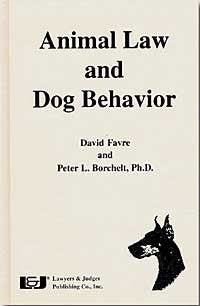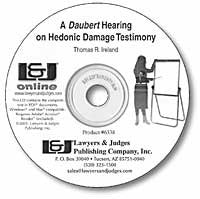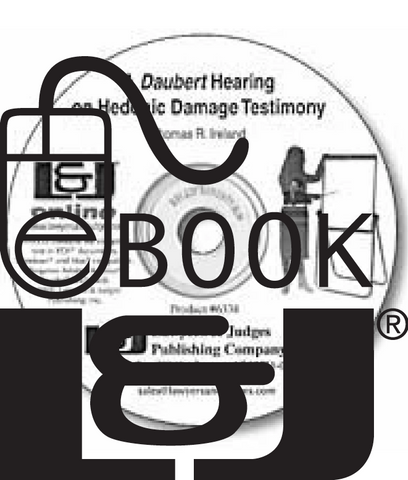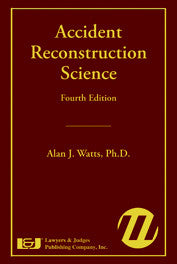
Animal Law and Dog Behavior
-
Author: David Favre, Peter L. Borchelt
-
ISBN 10: 0-913875-32-5
-
ISBN 13: 978-0-913875-32-2
-
Copyright Date Ed: September 14, 1999
-
Pages: 388
-
Binding Information: Casebound
- Size: 6 ✕ 9 Inches (US)
Know what constitutes normal and abnormal animal behavior.
If you are involved with animal legal issues, you will find that Animal Law and Dog Behavior gives all the information you need to decide what courses of action are possible and appropriate. A veritable refresher course on the legal matrix concerning animals, it focuses on the species most troublesome to individuals and the legal system: dogs.
With up-to-date information on the current state of the law, most cases examined are lower-court opinions from 1960 to the present. Well reasoned and analyzed, they may be used to draw together the national outlook on a particular issue. In areas where state statutes play a predominant role in articulating the law, the authors have selected regional states whose statutes are most representative of these areas.
As animals become an increasingly important part of our lives, disputes between people about animals and conflicts between people and animals are likely to increase. For this reason, it is especially important for attorneys to understand which behaviors are considered normal and which are considered abnormal.
This book is also available as a Kindle E-book. Click here to purchase and download:
TOPICS COVERED
- Animal behavior related to dogbite statutes
- Behavioral discovery in dog-related injury cases
- Defenses for owners
- Ethology and epidemiology of canine aggression
- Evaluation of fatal dog bites
- Liabilities of an owner or keeper
- Pack behavior of dogs
- Rights of ownership
- The dog bite problem
- Veterinarian malpractice
Table of Contents
Animal Law and Dog BehaviorDavid Favre and Peter L. Borchelt, Ph.D.
Contributing Authors: Alan M. Beck, Sc.D., James R. Lauridson, M.D., Randall
Lockwood, Ph.D., Laurence Myers, D.V.M., Ph.D., Richard H. Polsky, Ph.D., Vivien
Tsang, Victoria L. Voith, D.V.M., Ph.D.
Chapter 1: Introduction
1.1 The Use of this Book
1.2 Animal Rights
1.3 Terms and Categories
A. Animals
B. Classifying animals as wild or domestic
C. Dogs
D. Bees
E. Pets
F. Beast
G. Categories of Wildlife
Chapter 2: Ownership of Animals
2.1 Obtaining Title
A. Title by birth
B. Obtaining private ownership of wildlife
C. Finding a domestic animal--Common law
D. Sale and adoption of domestic animals
E. Gift
F. Being charged as a keeper of animals
G. Loss of title upon reversion of wildlife
2.2 State Ownership of Wild Animals
A. State ownership doctrine
B. Historical development of the doctrine
C. State control of private access to wildlife and limitations thereon
D. State ownership and the public trust doctrine
E. State liability as owner
2.3 Proof of Ownership--Branding and Registration
A. Overview
B. Statutory schemes
2.4 Rights of Ownership
A. Overview
B. Legal rights of animal ownership
C. Dogs
D. Civil recourse for interference--Conversion
E. Injury to animals by another--Torts
F. Criminal liability--Larceny
G. Overview of damages for injury to animals
H. The traditional calculation fair market value
I. Consequential damages
J. Intrinsic value
K. Punitive damages
L. Mental anguish or suffering of the owner
M. Loss of companionship
2.5 Bailment of Animals
A. The creation and nature of bailments
B. Bailment distinguished from lease, sale, joint venture, or gift
C. Duties of bailor and bailee
D. Bailor's recovery for loss or injury of bailed animal
E. Injury to bailee by animal--horse rentals
F. Injury to third party by bailed animal
G. The creation and components of an agistment bailment
H. Conflict with third party security interest of bailee
I. Agistment lien
J. Statutory provisions for agistment liens
K. Priority between agistment liens and security interest
2.6 Private Regulation--Landlord/Tenant and Condominiums
A. Pets within a lease
B. Defenses available to tenants
C. Condominiums
Chapter 3: Harm Caused by Animals
3.1 Introduction--Scope of the Chapter
3.2 The Dog Bite Problem
3.3 Introduction to Tort Law
A. Dangerous or vicious propensities
B. Role of animal behavior experts
C. Juries and going for the deep pocket
3.4 Liabilities of an Owner or Keeper
A. Strict liability based on vicious propensity
B. Negligence (other than vicious propensity)
C. Duty to invitees and patrons
D. Statutory liability--local ordinance
E. Statutory liability--state law
F. Common law trespass by animals
G. Fence-out statutes
H. Fence-in statutes herd districts
I. Animals on public highways
J. Males on the loose
K. Trespassing dogs
L. Lien on trespassing animal
M. Dogs and livestock
N. Wild animals possessed by private individuals
O. Wild animals "owned" by the government
3.5 Liability of Others
A. Land owner's duty to public
B. Special case of a landlord's duty to the public
C. Liability of prior owner
D. Liability of local government
E. Veterinarian's duty to others
3.6 Defenses for Owner
Chapter 4: State and Local Government--Animal Regulation
4.1 Exercise of Police Power by the State
A. Police power generally
B. Limitations on police power--individual constitutional rights
C. Federal preemption of state law
D. Limitations on state regulations
E. Dangerous dogs
F. Dogs (and other animals) harassing livestock
G. Compensation for the owner
H. Federal constitutional power
4.2 Police Power and Local Government
A. Local government--nuisance and zoning
B. Limitations on local authority
C. Zoning--kennels
D. Taking the dog from the home
Chapter 5: Veterinarian Malpractice
5.1 Introduction
5.2 Summary of Potential Legal Actions
5.3 Malpractice Distinguished
5.4 Malpractice Generally
5.5 Determining the Standard of Treatment
A. Expert testimony
5.6 Scope of Professional Responsibility
5.7 Proximate Cause
5.8 Defenses to Action of Malpractice
A. Statues of limitations
B. Good Samaritan
5.9 Revocation of License to Practice
Chapter 6: The Development of Anti-Cruelty Laws During the 1800s
Professor David Favre and Vivien Tsang
6.1 Introduction
6.2 The British Set the Stage
6.3 The Legal Framework in the United States
6.4 Early American Legislation
6.5 The Bergh Era Begins
6.6 New Legislation
6.7 Enforcement on the Streets of New York
6.8 The Ripple Effect
6.9 Taking the Laws to Court
6.10 A Voice of Concern
6.11 Conclusion
Appendix A
Chapter 7: Animal Behavior and the Law--An Introduction
Peter L. Borchelt, Ph.D.
Chapter 8: The Ethology and Epidemiology of Canine Aggression
Randall Lockwood, Ph.D.
8.1 Why Canids Bite
8.2 The Epidemiology of Dog Bites
8.3 The Victim
A. Age of victim
B. Sex of victim
C. Activity of victim
8.4 The Dog
A. Number of animals
B. Ownership of animals
C. Restraint
D. Sex and spayed or neutered status
E. Breed
8.5 Conclusions
Chapter 9: Dog Bites--Basic Behavioral Principals and Misunderstood Words
Peter Borchelt, Ph.D.
9.1 Behavioral Principals Relevant to the Issue of Dog Bites
A. Differences in behavior occur between breeds of dogs
B. All behavior develops over time, under to joint influence of genes and environment
C. Genetic environment
D. Environmental influence
E. Genetic selection for aggression
F. Aggression--specific behaviors
G. Complexity of aggression
H. Importance of context in aggression
9.2 Discussion of Some Common Words That are Frequently Misunderstood
A. "Vicious"
B. "Provoked" and "unprovoked"
C. "Socialization"
D. "Responsible" and "irresponsible" owners
9.3 Implications
Chapter 10: Attacks by Packs of Dogs Involving Predation on Human Beings
Peter L. Borchelt, Ph.D., Randall Lockwood, Ph.D., Alan M. Beck, Sc.D.,
Victoria L. Voith, D.V.M., Ph.D.
10.1 Introduction
10.2 The Three Cases Described
A. Case 1
B. Case 2
C. Case 3
10.3 Investigations Under Controlled Conditions
A. Case 1
B. Case 2
C. Case 3
10.4 Discussion
10.5 Addendum--A Fourth Case
10.6 Prevention of Dog Attacks
Chapter 11: Evaluation of Fatal Dog Bites: The View of the Medical Examiner and
Animal Behaviorist--A Case Report
James R. Lauridson, MD and Laurence Myers, D.V.M., Ph.D.
11.1 Case Report
11.2 The Dogs
11.3 The Victims
11.4 Behavioral Analysis
11.5 Case Behavioral Analysis
11.6 Discussion
11.7 Summary
Chapter 12: Guidelines for Behavioral Discovery in Dog--Related Injury Cases
12.1 The Applied Animal Behaviorist as an Expert Witness: How Can an Animal Behavior
Expert Help?
12.2 What Kind of Animal Behavior Expert is Best Qualified for the Job?
12.3 Guidelines for Discovery
12.4 Conclusion
Appendix: Deposition Questions for the Owner of the Dog
Chapter 13: Issues About Animal Behavior Related to Dog Bite Statutes
Richard H. Polsky, Ph.D.
13.1 A Review of Statutes
13.2 Issue #1: Did a Dog Bite Actually Occur?
13.3 Issue #2: Which Dog Did the Biting?
13.4 Issue #3: Was the Dog Provoked?
13.5 Issue #4: Did the Plaintiff Assume the Risk of Being Bitten?
13.6 Conclusion
Chapter 14: Practical Issues to Consider in the Investigation and Evaluation of
Fatal or Serious Dog Attacks
Peter L. Borchelt, Ph.D.
14.1 Animals as Evidence
14.2 How Many Animal Behaviorists Does It Take...?
14.3 Who Hires and Pays
Table of Cases
About the Authors
Index




